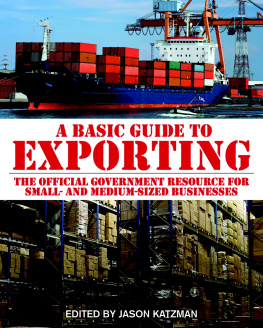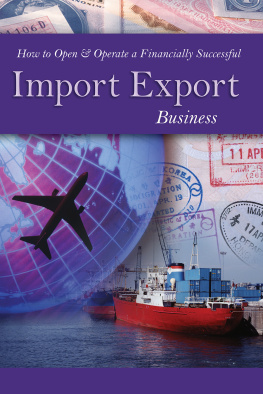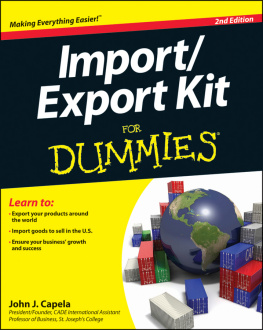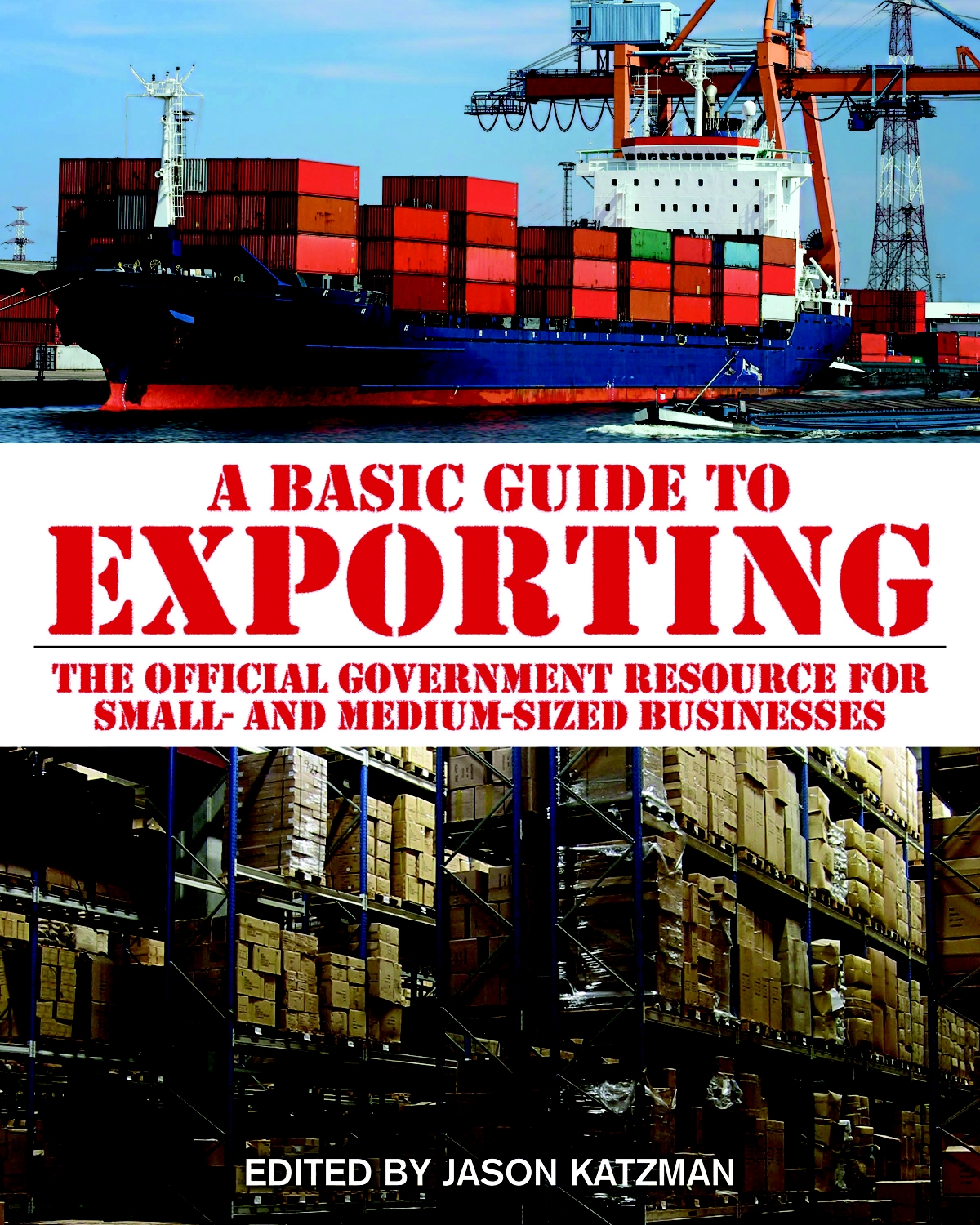Publishing a book is a journey that requires endurance, persistence, and, above all, dedication. Many people contributed to this one, and prime among them was Doug Barry of the U.S. Commercial Service, who guided its updating and production. He brought together the knowledge and skills of many individuals in the world of international trade and lent a fresh voice to this venerable text. It is due to his efforts that this book appears again, 70 years after the publication of its first edition in 1938.
Colleagues at the International Trade Administration (ITA) who contributed to this new edition include Jennifer Kirsch, who looked after all the details and kept the project moving forward.There would be no book without her skill.
John Ward, the publications director in the ITAs Office of Public Affairs, has encyclopedic knowledge of how books come together and much of what he knows is applied in the pages that follow. A book should be a pleasure to pick up. Because of John, this one is.
The work of updating this new edition began several years ago at the U.S. Export Assistance Center in Atlanta, Georgia.Tom Strauss heard from clients that a new book was needed, and he started compiling information with the help of an international trade specialist, Bob Abrahams. Others throughout the International Trade Administration made considerable subsequent contributions. Trade specialists Keith Hwang and Bob Deane read the manuscript and provided useful comments and clarifications. Curt Cultice, senior media specialist at the U.S. Commercial Service, assisted in writing of some of the case studies. Michele Robinson of the ITAs Office of Public Affairs and Philip Kolb of the U.S. Commercial Service provided production assistance. Interns Robert Herren and CourtneyTrumpler also assisted production by researching the books photos and publishing history.
On the production side, many thanks are due to Linda Stringer of Publications Professionals LLC for her careful editing of the text, to Kia Penso and Ashley Young for additional editorial assistance, and to the books design team, led by Amanda Drake of the Creative Services division of the U.S. Government Printing Office and Anne Masters of Anne Masters Design Inc.
APPENDIX A: GLOSSARY
Air waybill: Bill of lading that covers both domestic and international flights transporting goods to a specified destination. It is a non-negotiable instrument of air transport that serves as a receipt for the shipper, indicating that the carrier has accepted the goods listed therein, and obligates the carrier to carry the consignment to the airport of destination according to specified conditions.
Antidiversion clause: To help ensure that U.S. exports go only to legally authorized destinations, the U.S. government requires a destination control statement on shipping documents. Under this requirement, the commercial invoice and bill of lading (or air waybill) for nearly all commercial shipments leaving the United States must display a statement notifying the carrier and all foreign parties that the U.S. material has been approved for export only to certain destinations and may not be diverted contrary to U.S. law.
Antidumping duty: Special duty imposed to offset the price effect of dumping that has been determined to be materially harmful to domestic producers. (See also dumping .)
Arbitration: Process of resolving a dispute or a grievance outside of the court system by presenting it to an impartial third party or panel for a decision that may or may not be binding.
Bill of lading: Contract between the owner of the goods and the carrier. For vessels, there are two types: a straight bill of lading, which is not negotiable, and a negotiable, or shippers orders, bill of lading. The latter can be bought, sold, or traded while the goods are in transit.
Carnet: Standardized international customs document known as an ATA ( admission temporaire or temporary admission ) carnet that is used to obtain duty-free temporary admission of certain goods into the countries that are signatories to the ATA Convention. Under the ATA Convention, commercial and professional travelers may take commercial samples; tools of the trade; advertising material; or cinematographic, audiovisual, medical, scientific, or other professional equipment into member countries temporarily without paying customs duties and taxes or posting a bond at the border of each country to be visited.
Cash in advance (advance payment): Payment from a foreign customer to a U.S. exporter prior to actually receiving the exporters products. It is the least risky form of payment from the exporters perspective.
Certificate of origin: Signed statement required in certain nations attesting to the origin of the export item. Certificates of origin are usually validated by a semiofficial organization, such as a local chamber of commerce. A North American FreeTrade Agreement (NAFTA) certificate of origin is required for products traded among the NAFTA countries (Canada, Mexico, and the United States) when duty preference is claimed for NAFTA qualified goods.
CFR: Cost and freight to a named overseas port.
CIF: Cost, insurance, and freight to a named overseas post. The seller quotes a price for the goods shipped by ocean (including insurance), all transportation costs, and miscellaneous charges to the point of debarkation from the vessel.
CIP: Carriage and insurance paid for delivery to a named destination.
Commercial invoice: Document prepared by the exporter or freight forwarder and required by the foreign buyer to prove ownership and to arrange for payment to the exporter. It should provide basic information about the transaction, including a description of goods, the address of the shipper and seller, and the delivery and payment terms. In most cases, the commercial invoice is used to assess customs duties.
Confirming house: Company, based in a foreign country, that acts as a foreign buyers agent and places confirmed orders with U.S. exporters. The confirming house guarantees payment to the exporters.
Consignment: Delivery of merchandise to the buyer or distributor, whereby the latter agrees to sell it and only then pay the U.S. exporter. The seller retains ownership of the goods until they are sold but also carries all of the financial burden and risk.
Consular invoice: Document required in some countries that describes the shipment of goods and shows information such as the consignor, consignee, and value of the shipment. Certified by the consular official of the foreign country stationed in the United States, it is used by the countrys customs officials to verify the value, quantity, and nature of the shipment.
Contract: Written or oral agreement that is legally enforceable.
Copyright: Protection granted to the authors and creators of literary, artistic, dramatic, and musical works, sound recordings, and certain other intellectual works. A computer program, for example, is considered a literary work in the United States and some other countries.
Countertrade: General expression meaning the sale or barter of goods on a reciprocal basis. There may also be multilateral transactions involved.
Countervailing duties: Additional duties imposed by an importing country to offset government subsidies in an exporting country when the subsidized imports cause material injury to domestic industry in the importing country.
CPT: Carriage paid to a named destination. This term is used in place of CFR and CIF for all modes of transportation, including intermodal.







